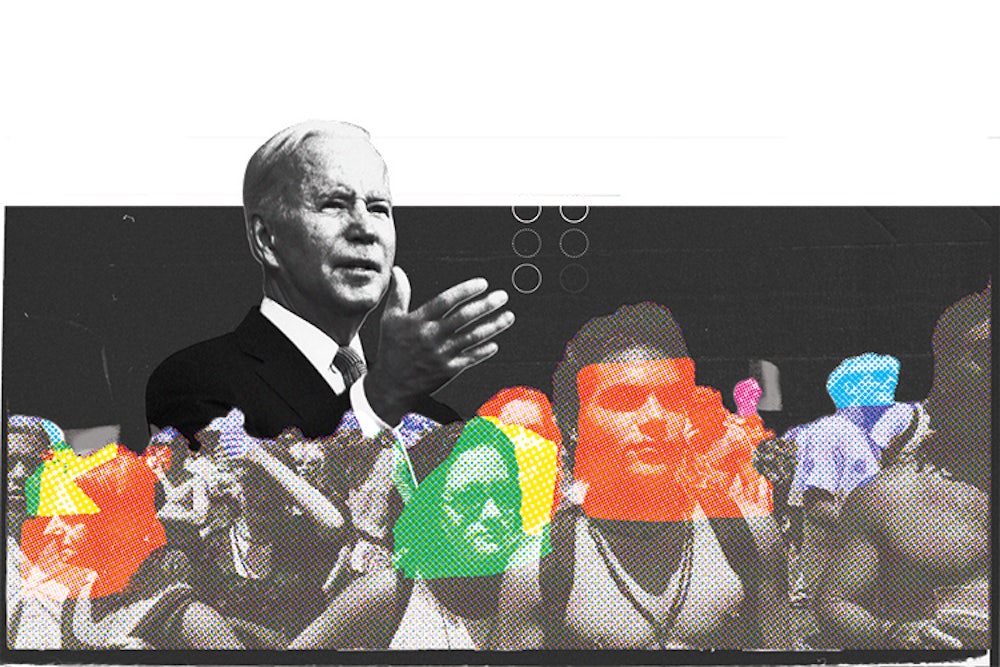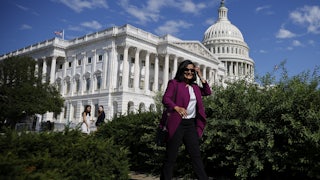Joe Biden has a problem with young voters. A big problem, in fact. His approval rating is underwater with 18- to 34-year-olds by a staggering 35 points, as per a July poll from Monmouth University. Only 28 percent of these voters approve of his performance, down 31 points from when Biden took office less than two years ago. A recent New York Times/Siena College poll, meanwhile, was even more dismal: Ninety-four percent of 18- to 29-year-olds think the Democrats should nominate a different candidate in 2024. His descent with the young has dramatically outpaced that of other age groups; it has coincided with a similarly steep drop-off among Black and Hispanic voters.
It is also something of a mystery. Inflation is particularly important for these voters, who are less likely to be homeowners than their parents and are seeing the cost of everything skyrocketing. But then again, so is everyone. Young voters tend to be more progressive and in favor of universalist policies—they were far more likely to vote for Bernie Sanders than they were for Biden in the 2020 presidential primary. Biden has made numerous rhetorical shifts to the left since winning the Democratic nomination but has watched Democrats like Joe Manchin and Kyrsten Sinema stymie his more ambitious efforts. There is, always, the question of vibes. Biden, who turns 80 shortly before Thanksgiving, is no one’s idea of a youth candidate and is certainly the squarest Democratic president since Lyndon Baines Johnson.
Biden’s struggles also point to a gnawing anxiety among many Democrats: that they’ll suppress young voter turnout in the midterms to historic lows. Will young Democrats’ growing disaffection with Biden matter in the midterms? And can Democrats do anything to stop it?
After a brutal 2021—and a sluggish start to 2022—the progressive left won a crucial victory in Pennsylvania’s 12th Congressional District. Summer Lee, a 34-year-old community organizer endorsed by Bernie Sanders and Alexandria Ocasio-Cortez, overcame massive spending from outside groups to narrowly defeat Steve Irwin, a Pittsburgh attorney with the backing of the Democratic establishment. Lee backs policies like the Green New Deal and Medicare for All and will likely slot in with “the Squad”—the group of young, lefty members of the House that includes Ocasio-Cortez, Rashida Tlaib, Ayanna Pressley, and Ilhan Omar. Her victory, in some ways, reflects a new Democratic coalition that is emerging in western Pennsylvania—a transition from one rooted in manufacturing to one in health care. But it also pointed to a solution to one of Democrats’ biggest problems: their struggles with young voters.
“Youth voter turnout was crucial to Summer Lee,” Usamah Andrabi, a spokesperson for Justice Democrats, a progressive group that backed Lee, told The New Republic. “That’s the future of districts like that. There was a big push to make that happen and to focus on the issues that actually matter—climate change, universal health care, Supreme Court reform—and fight for those issues—that’s why you saw young voters flock behind a progressive like Summer Lee.”
Lee is, of course, something of an outlier. Most of the candidates running are incumbents, nearly every Democratic primary has concluded, and there are few new Squad contenders in the mix—not that that would necessarily be a boon everywhere in the United States. She’s young and will likely be Pennsylvania’s first Black woman representative—the district, which covers parts of Pittsburgh and its suburbs, is deep blue. But, while the party has seen its first batch of zoomer candidates—25-year-olds Maxwell Frost and Ray Reed, both of whom are Black, are running to represent Florida’s 10th District and Missouri’s 2nd—the Democratic Congress remains, by and large, old and white. The average age of its congressional leadership is 72; the Democrats whom young voters are most likely to encounter are Biden (79), House Speaker Nancy Pelosi (82), and Senate Majority Leader Chuck Schumer (a spring chicken at 71). A first-time voter in 2022, meanwhile, may have only faint memories of Barack Obama’s presidency; even those up to about age 30, unless they were unusually political youngsters, missed out on his transformational 2008 presidential campaign.
It’s not just age, of course. The sitting president’s party has gained seats in the first-term midterms only twice, both in extraordinary circumstances: once after Franklin D. Roosevelt’s first two years in office, in which he launched the New Deal, and again a year after the September 11 terrorist attacks.
“In a political environment that’s as nationalized and polarized as ours is, people’s view of the president will largely determine, I think, their view of Democrats as a whole—so certainly, the fact that the president is having a tough time staying above water will have really significant implications for Dems down the ballot,” McKenzie Wilson, communications director at Data for Progress, told TNR. “That doesn’t mean that there aren’t things that Democrats and President Biden can do between now and November to help fix that, though. But it definitely means that there’s a need for some concerted effort here to make young people feel like our political system and the president specifically are pushing for policies that are important to them and impact their lives.” That may be a struggle, however. After a grueling primary, Biden tacked left on the campaign trail, winning over Sanders supporters with pledges of an “FDR-sized presidency.” He pushed bold action to fight climate change and protect reproductive rights, and he proposed a raft of spending to back his pledge for a new New Deal. Nearly two years into Biden’s presidency, his agenda has shrunk. The Inflation Reduction Act, though unquestionably his greatest legislative accomplishment as president, nonetheless is a fraction of the Build Back Better Act from which it came. His other notable legislative accomplishments are a stimulus package that has largely been forgotten, a compromise infrastructure bill that is big but whose effects aren’t felt yet, and, perhaps most impressively, the first piece of federal gun control legislation in decades. That bill, which required the votes of 10 Republicans and received the votes of 15, nevertheless is not exactly a gun control bill per se and mostly revolves around closing loopholes, expanding background checks, and providing mental health and security funding for schools. It was, like much of Biden’s last year, also beset with bad luck: It was signed into law just the day after the Supreme Court repealed Roe v. Wade and buried beneath an avalanche of stories about the loss of women’s bodily autonomy.
The failure to fulfill promises made on gun safety and reproductive rights is surely driving much of the discontent among young voters. So is a larger disconnect: the sense that Democratic leadership does not take their struggles seriously. “One of the big takeaways for me from writing my book is just how widespread disaffection is with these people, I mean especially among young people,” Raina Lipsitz, author of The Rise of a New Left: How Young Radicals Are Shaping the Future of American Politics, told TNR. “Very young people have been through a lot in a very short time. They’ve seen two different waves of Black Lives Matter essentially, 2013 to 2016 and then the summer of 2020, in response to the same problem: really grotesque acts of police brutality that we never addressed or fixed, that just keep happening. They’re seeing a worsening climate crisis. They’re seeing a second major economic recession. They’ve lived through a global pandemic where a million Americans died because the government horrifically mismanaged it. This ongoing crisis of gun violence that they very much grew up in the shadow of and don’t see anybody really doing anything about. It’s not just Biden, but I think Biden is a particularly good representative of everything that’s out of touch and clueless.”
The willingness to campaign on such crises but then struggle to pass meaningful legislation—often because of slim majorities or arcane rules—only drives this dissatisfaction. One solution would be to find a way to break the legislative gridlock that has hampered the Biden administration since last summer. That, of course, will be hard to do in a Senate with only 50 Democrats, two of whom are Joe Manchin and Kyrsten Sinema. More aggressive executive orders—like one that would have declared a public health emergency in response to the overturning of Roe v. Wade, which the administration considered but tabled—would be one option. Executive actions, of course, are hardly a political balm. Increasingly utilized to get things done in a polarized and dysfunctional political system, they proved little help for Barack Obama and Donald Trump in midterm elections in 2010, 2014, and 2018.
“Delivering on promises when you’re coming out of a crisis matters. People want something big, bold, and concrete,” Andrabi told TNR. “Instead, too often, they’re getting a lack of action. Without that, you’re going to see disaffected young voters wondering what’s the point of going to the polls when that’s exactly what they did two years ago. And they did it with the promise of fighting climate change, acting on gun violence, student debt cancellation, and protecting reproductive rights. Almost none of that has happened.”
One option would be to take up a polarizing issue that is uniquely important to the young, like student debt cancellation. Although this remains contentious with the wider electorate, it’s broadly popular among young voters for obvious reasons, despite the fact that only a third of voters under the age of 30 carry it. Biden has shown more willingness to cancel debt and has recently moved to cancel the federal student loan debt of about 200,000 people—a small step that is far from full cancellation.
Messaging, something Biden has struggled with as his poll numbers have dipped, may help. “I think the times where he has talked to the public—after the shooting in Illinois, after Roe v. Wade—I don’t think he’s really set a tone of assurance and anger and leadership in the way that a lot of young people, I think, look around the country and feel,” Wilson said. “It’s not easy,” she continued. “I feel like there’s a way for the Biden admin to be more tactical about the good things that they do. Are they communicating about it effectively to young people? There’s been [a] huge rise in activism around gun safety in the last several years, especially with young people leading. I don’t see him using the fact that he passed this bill as a way to persuade young people that their involvement does have an impact.”
Ultimately, Democrats in November do have one thing going for them that’s unlikely to change: They’re not Republicans. The same Monmouth poll found that 59 percent of young voters want Democrats to retain control of Congress in November, compared to only 34 percent who prefer the GOP. That suggests the collapse isn’t total, and that it may, in fact, largely be focused on Biden himself. But disaffection with Biden is clearly dampening enthusiasm among young voters, whom Democrats desperately need in November. They’re running out of time. Worse, it’s not clear they have any idea what to do.
This article has been updated.






